Tonga & Fiji Birds
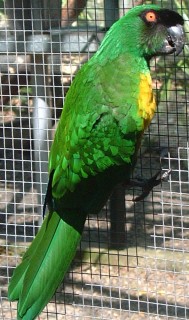 |
Viti Levu (the main island of Fiji) has its own parrot, the Masked Shining Parrot
Prosopeia personata. Also known as the Sulphur- or Yellow-breasted Musk
Parrot, and the Masked Parrot, it is a slim green parrot with a characteristic
black mask on its face, and a bright yellow breast. A forest bird, it is found
from sea level to 1,200 meters (3,800 ft) in the mountains of Viti Levu where it feeds on
fruits in the canopy, but also takes crops such as bananas. This photo was
taken at the Kula Eco Center on Viti Levu. |
| The Red Shining Parrot Prosopeia tabuensis is
endemic to Fiji but has been introduced to Tonga. It is a medium sized,
long-tailed red parrot with a green back and blue on the nape, tail and wings.
Coloration varies somewhat from island to island, especially in the amount of
blue on the nape and the shade of red (which can be crimson, red, or maroon).
Several Kadavu (Fijian) parrots inhabit the trees of Treasure Island Resort in
the Mamanucas, squawking loudly as they forage for fruits, seeds and insects.
They inhabit forests and plantations, and are often solitary or in pairs. The
photo was taken at Dravuni village in the Kadavu Group. |
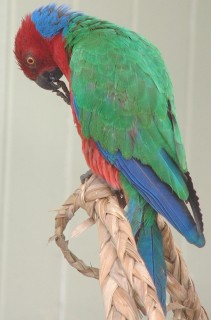 |
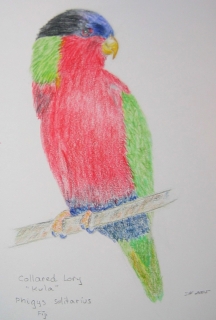 |
The Collared Lory Phigys
solitarius (left) is endemic to Fiji, and is locally known as the Kula Bird. This
short, chubby parrot has a patterned array of color: red, green, and deep purple
with a yellow bill. It is common throughout Fiji in the lowland
coastal forests and plantations where it feed in flowering trees including the
coconut and African tulip. |
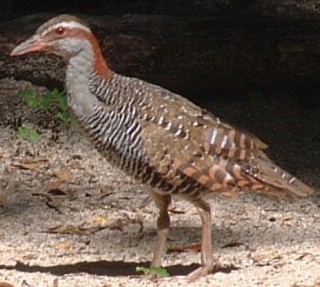 |
| On Elevuka Island (Treasure
Island Resort) in the Mamanucas of Fiji we were thrilled to find dozens of Banded
Rails Rallus philippensis (right) foraging among the shrubs. In mid-summer
they had dozens of fluffy chicks. These sturdy birds with lovely reddish brown
crown, nape and eye stripe have been extirpated from Viti Levu because of the
introduced mongooses which prey on this nearly flightless bird and feed on its
eggs. Rails apparently can be quite strong flyers and have colonized many remote
Pacific Islands, but once established they tend to become flightless.
This bird is also called the Buff-banded Rail and the Banded land Rail. |
 |
The Orange Dove (left) is found on the islands of northern Fiji (Vanua Levu, Taveuni)
where it feeds on berries and fruits in the forest and open bush. |
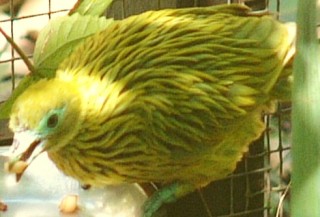 |
| We met two of Fiji’s endemic doves, the Orange Dove Ptilinopus victor
and the Golden Dove Ptilinopus luteovirens, at the Kula Eco Center on Viti
Levu. The Golden Dove (right) is found on Viti Levu and other islands of central
Fiji where it may be found in the high canopy of the forest, often hanging upside down
to reach fruits. Its wings whistle in flight. Males appear golden in
flight, and females are bright green all over. When seen up close, you
can see the strange texture of the long, overlapping feathers and the blue eyes. |
| Three birds of prey are found in
Fiji, including one in Tonga, but we have only observed one not in captivity:
the Swamp Harrier Circus appproximans. This large hawk, also
called the Australasian Harrier, can be seen soaring or hovering usually in open
countryside, although we have seen several around the Royal Suva Yacht Club,
just a few miles outside the city. These long-winged and long-tailed birds have
plumage that varies from all dark brown (possibly immatures) to brown with
buff-colored, barred tails. They nest on the ground in swamps and marshes.
Their food usually consists of small reptiles, mice or birds. |
 |
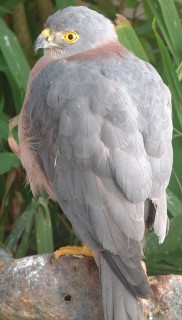 |
The only accipiter in Fiji is the Fiji Goshawk Accipiter rufitorques which
is endemic. It makes its home anywhere from dense forest to urban areas. It rarely soars,
but is more likely to be
seen using a flap and glide flight, or a low, twisting flight to capture prey. It is
identifiable by its blue-gray plumage with a brownish pink area below and around
the neck. It is often mobbed by smaller birds. |
| The Peregrine Falcon Falco
peregrinus is the only falcon recorded in Polynesia. Nesting in
cliffs, these hunters feed on birds which they take in flight. In Fiji they have
been seen to take flying foxes (fruit bats) as well. Although the Fijian
residents are of the same species as those found elsewhere, they have strikingly
different plumage: a fully black head and paler back than those of the
continents. They are listed as an endangered species but their status in
Fiji is not well recorded. A successful breeding program is underway at
the Kula Eco Center on Viti Levu, where they have several dozen breeding pairs. |
 |
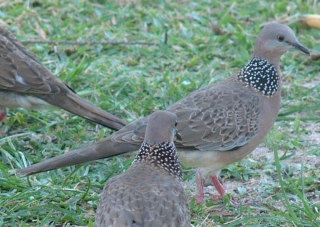 |
The Spotted Dove Streptopelia chinensis was introduced to Fiji in the
1930's and has flourished on the islands. We saw many of them on Likuri
(Robinson Crusoe) Island. In September, the austral spring, the males were often
heard and seen doing their mating dance. The male would puff up his collar,
squat low to the ground then pump up and down while letting out a deep woo‑coo,
woo‑coo. We photographed one below, following an uninterested female. |
 |
Living on a boat we are lucky to be able to watch many of the
seabirds that inhabit these islands. Most of these birds are “old
friends” - species we have come to identify easily as we have crossed the
oceans. In Tonga the most common sea birds were the Black Noddy Anous
minutus, a dark gray to black tern with a strikingly white forehead, and the
Black-Naped Tern Sterna sumatrana, a nearly all-white bird with a narrow,
black nape. In Fiji the most common terns are the Great Crested Tern Sterna
bergii, a large tern with a black cap and prominent crest, and the petite,
all white Fairy Tern.
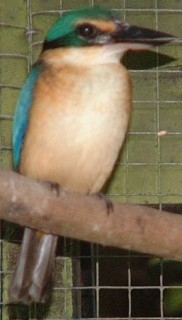 |
Perched on mangrove branches or power lines, the stout Collared Kingfisher Halcyon chloris is a
striking bird, with its blue back and head, and white collar with a rusty eyebrow. We
have seen it in Tonga along the coast and in Fiji along the Navua River. The
photo was taken at the Kula Eco Center, Viti Levu, Fiji. This Kingfisher is widespread from
the Red Sea, to Australia and the tropical Pacific. It is also known as the
White-collared Kingfisher and the Mangrove Kingfisher. As is true of most of the tropics,
there are a large number of species but a relative scarcity of individuals. Our
observations bear this out. We have seen (or have read that there are) many bird
species on the islands of Tonga and Fiji, but we've rarely seen more than one
individual of a species at a time, and sometimes weeks pass without seeing that
species again. For example, in the islands of Fiji’s Kadavu Group we pointed out
a lone Frigate-bird to our niece, Emmy, who was visiting. It was the first one
we had seen in several months.
|
| Around Tonga and Fiji we have seen frigate-birds (lesser and great) in flight,
boobies (brown Sula leucogaster and red-footed Sula sula) diving
for fish, and many Pacific reef herons Egretta sacra stalking prey on the edge
of reefs at low tide. An unusual reef heron wandered the shore near Musket Cove
in Fiji where we left for the boat for two months in 2005. It was bi-colored white
and gray, apparently a rarer phase than the all gray or white phase. The
Pacific Reef Heron (also known as Pacific Reef Egret) forages alone or in pairs
on exposed mud flats, reef edges, and in taro fields and freshwater streams.
These birds are characterized by their heavy bills, greenish-yellow legs and
stout, chunky appearance. |
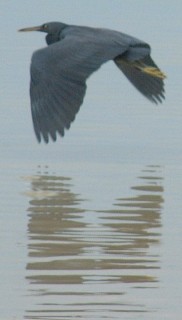 |
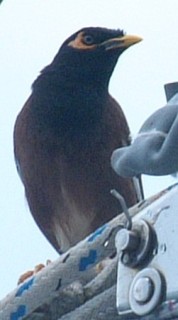 |
By far the most commonly seen (and
heard) bird in Fiji is the Common, or Indian Myna Acridotheres tristis,
an introduced species that has virtually taken over the country with it
abundance. In Suva alone, at dusk each day thousand of mynas swirl above the
streets and settle in the massive ficus trees, or on the roofs of the commercial
dock buildings creating a great ruckus and flurry. It is a handsome
brown and black bird with distinctive white patches on the belly, undertail
coverts, and wings, and sporting a bright yellow area of bare skin around the
eyes. Another introduced species, the
Red-vented Bulbul Pycnonotus cafer is fairly common in urban areas. It is
a dark crested bird with white rump and tail tip, and bright red undertail
coverts. We've seen these birds in French Polynesia’s Society Islands,
Tonga and Fiji. Like the common Myna, it is a native of India.
|
A beautiful little finch found only in Samoa and Fiji is the Red-headed Parrotfinch
Erythrura cyaneovirens. Although they are known to be gregarious in Fiji (they are shyer in Samoa) and
we have seen them very close up, we have not been able to get a picture of this
lovely blue-green bird with a bright red head (male) and red rump. They are
often foraging in the bushes by the road or in the grass in parks.
| A small Fijian endemic bird is
Layard’s White-eye Zosterops explorator, which is found in many habitats,
including urban gardens. Similar in appearance to the Silvereye, Zosterops
lateralis (which we saw often in Tahiti), the Layard’s has a complete white
eye-ring (unlike the Silvereye which is broken in front of the eye.) The
Layard’s is olive green above with a yellow throat and breast. |
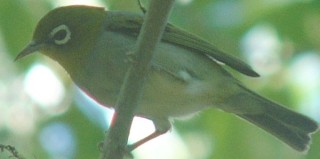 |
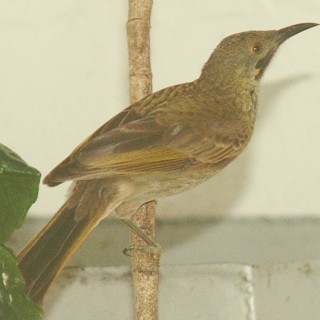 |
This medium sized honeyeater (Note
the down-curved bill) was photographed at the Kula Eco Center on Viti Levu,
Fiji. The Wattled Honeyeater Foulehaio carunculata is olive green with a
small orange wattle surrounded by black (Fijian birds). It is aggressive and
noisy, and might harass larger birds. It feeds on nectar, insects and even small
lizards. It is endemic to central Polynesia, with subspecies on Wallis,
Futuna, Samoa and Tonga, and two sub-species in Fiji. On Viti Levu, Fiji, at an
elevation of 600 feet, perched on a plantain plant we saw one of Fiji’s more
beautiful endemic birds: the Orange-breasted Honeyeater Myzomela jugularis.
This small bird with a down-curved bill (characteristic of the honeyeaters) has
a black back and bright yellow-orange breast and a white-tipped tail. The male
has red on its crown and rump. It is seen in forest edges and village parks and
gardens feeding on flowering trees and shrubs. It is also called the
Orange-breasted Myzomela.
|
NOTE: When possible, we have photographed birds in the
wild, but given the time delay of the digital camera, the difficulty in asking
foraging birds to sit still, and our own lack of expertise, we have included
some shots taken at Kula Eco Center in Viti Levu, Fiji. This wildlife
rehabilitation and education center (which takes its name form the popular
“kula bird” or Collared Lory) houses wounded animals that can no longer survive
in the wild, and has a successful breeding program for Fiji’s endangered
peregrine falcons. All photos from the Eco Center were taken by Amanda.
Up | Tonga & Fiji Flora | Tonga & Fiji Fauna | Tonga & Fiji Birds
Tonga Home
| Tonga Newsletters
| Tonga Diving
| Tonga Cruising Info
| Fiji Home
| Fiji Newsletters
| Fiji Diving
| Fiji Cruising Info
West Indies Flora/Fauna | Venezuela Flora/Fauna | SW Caribbean Flora/Fauna | Galapagos Flora/Fauna | Fr. Polynesia Flora/Fauna | Tonga & Fiji Flora/Fauna | Australia Flora/Fauna | Southeast Asia Flora/Fauna | Sri Lanka Flora/Fauna | Madagascar Flora/Fauna | Marine Mammals
Top Level:
Home |
Destinations |
Cruising Info |
Underwater |
Boat Guests |
Ocelot |
Sue |
Jon |
Amanda |
Chris |
Site Map |
Make a Comment
 |
Lifetime
Commodores
of the
Seven Seas
Cruising
Association |
 |
|
If our information is useful,
you can help by making a donation
|
Copyright © 2000‑ Contact:
Jon and Sue Hacking -- HackingFamily.com, svOcelot.com.
All rights reserved.
